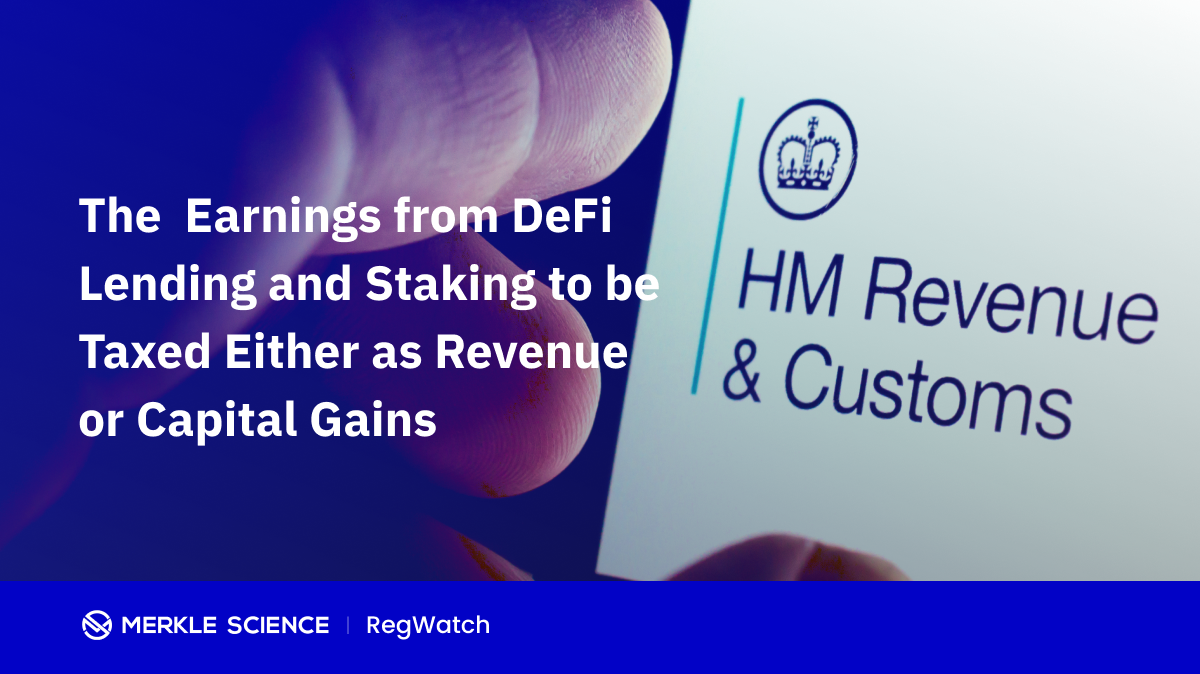The HMRC Updates its Guidance to Provide Clarity on Taxation of Earnings from DeFi Lending and Staking

Merkle Science

As the crypto and Decentralized Finance (DeFi) momentum gains traction, there has been a parabolic rise in market participants. The year 2021 saw the influx of both retail investors and institutional service firms space into the market. The surge in the crypto and DeFi’s growth has also garnered the interest of various regulatory bodies including the federal taxing agencies.
While presenting the federal budget on February 1, 2022, India’s finance minister Nirmala Sitharaman stated that “there has been a phenomenal increase in transactions in virtual digital assets. The magnitude and frequency of these transactions have made it imperative to provide for a specific tax regime.” Any income from virtual assets including non-fungible tokens (NFTs) will now be taxed at 30% in India. Contrastingly, after the feedback from the investors and stakeholders Thailand withdrew its plans for a 15% crypto tax this week.
With taxation of digital assets being under focus this week, Her Majesty’s Revenue and Customs (HMRC) —UK’s tax agency — announced on February 2, 2022, that it has updated its guidance on the treatment of crypto and digital assets. The HMRC has provided broad guidelines governing the taxation of earnings from DeFi lending and staking networks.
The HMRC guidance on DeFi leads to more confusion
Though the updated guidance seeks to provide clarity on how the proceeds from DeFi lending and staking will be taxed, in reality, it creates more ambiguity on whether proceeds from lending and staking will be considered capital gains or revenue. Admitting that lending/staking in DeFi is constantly evolving, the HMRC stated that, it is not possible to envision all the circumstances in which lender/liquidity provider earns a return. Therefore, the HMRC has set out a series of guiding principles that act as general guidelines on determining the nature of returns related to DeFi lending or staking.
In the updated guidance the HMRC has published some instances designed to assist individuals in ascertaining whether their returns fall under the income/revenue category.
- First, if the return to be received by the lender/liquidity provider is known to him at the time when the agreement is made
- Second, when the return is paid by the borrower or the DeFi lending platform to the lender/liquidity provider
- Third, when the return is paid periodically throughout the entire duration of the lending/staking or when it is paid upon repayment of the principal
- Lastly, when the return was earned by the lender/liquidity provider by providing a service to the borrower/DeFi lending platform
Similarly, the HMRC also listed out four instances where the returns from DeFi lending/staking will have the nature of capital gains
- First, when the return to be received is unknown and speculative
- Second, when the lender/liquidity provider receives one-off payments for the service provided
- Third, where the lender/liquidity provider is not rewarded by the borrower or the DeFi platform for providing their services, but rather the lender/liquidity provider seeks to benefit from their activities through the growth in value of a capital asset
- Lastly, when the return is realized through the disposal of a capital asset
Crypto UK — one of the leading self-regulatory trade associations for the UK crypto industry — interprets the last clause to mean that “when a token is lent or staked into a platform or protocol, it may be classified as a disposal by the HMRC for tax purposes at the moment the token leaves the user's wallet.” This means that the transaction will be subjected to capital gains tax reporting requirements as soon as the tokens leave the user’s wallet. According to Crypto UK, this rule is slightly arbitrary because the user still has control over the assets and expects them to be returned at some point in the future. Therefore, logically the assets still belong o the user and not the platform.
Further, as per the provisions of the updated guidance, the HMRC plans to treat crypto as a property for tax purposes. Ian Taylor, the Executive Director of CryptoUK pointed out that this approach is inconsistent with the categorization approach currently being adopted by the government and other regulatory bodies in the UK, including the Treasury and the Financial Conduct Authority (FCA) who regard crypto assets as financial instruments and regulate them as in line with other financial services and products.
Under the present regime, the difference in capital and revenue tax regimes is significant. The capital gains tax is 20% for income from other chargeable assets including crypto. Whereas the base rate for revenue tax is 20% applied to income between £12,570 and £50,270. On incomes of between £50,271 and £150,000, there is a tax rate of 40%. For over £150,000, the tax rate is 45%. According to Fxempire — a global financial news portal — similar to rental income from residential property and capital gains applied to the sale of said property, for investors that stake crypto and then sell their crypto, there could also be double taxation.
How can Merkle Science help?
To enable access to complete benefits of crypto assets while mitigating the risks they pose to users, investors, and the financial system, the regulatory oversight over crypto assets is increasing. To protect themselves from exposure to the AML/CFT risks, VASPs should proactively put compliance frameworks in place to monitor all transactions surrounding stablecoins and to mitigate AML/CFT risks.
Merkle Science provides a predictive crypto risk and intelligence platform, setting the standard for the next generation of financial safeguards and criminal detection. We are creating the infrastructure necessary so that a full range of individuals, entities, and services may transact safely with crypto. Merkle Science’s highly customizable platform and proprietary Behavioral Rule Engine is easy-to-use, allowing institutions to detect illicit activity beyond the blacklists and detect suspicious activity that could have previously been undetected.


